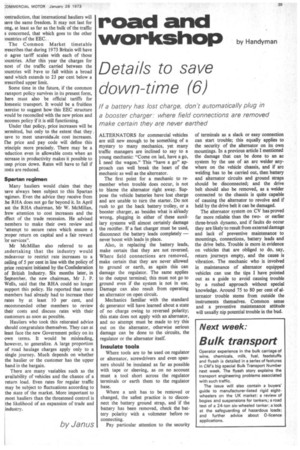road and
Page 41

If you've noticed an error in this article please click here to report it so we can fix it.
workshop by Handyman
Details to save down-time (6)
If a battery has lost charge, don't automatically plug in a booster charger: where field connections are removed make certain they are never earthed
ALTERNATORS for commercial vehicles are still new enough to be something of a mystery to many mechanics, yet many traffic managers are inclined to say to a young mechanic: "Come on lad, have a go, I need the wagon." This "have a go" approach can well break the heart of the mechanic as well as the alternator.
The first point for a mechanic to remember when trouble does occur, is not to blame the alternator right away. Suppose the vehicle batteries have lost charge and are unable to turn the starter. Do not rush to get the hack battery trolley, or a booster charger, as besides what is alieady wrong, plugging in either of these auxiliary systems will almost certainly damage the rectifier. If a fast charger must be used, disconnect the battery leads completely — never boost with leads in place.
Also, in replacing the battery leads, make certain that they are not reversed. Where field connections are removed, make certain that they are never allowed to ground or earth, as again this can damage the regulator. The same applies to the output terminal; this must not go to ground even if the system is not in use. Damage can also result from operating an alternator on open circuit.
Mechanics familiar with the standard dc generator will have learned about a state of no charge owing to reversed polarity; this state does not apply with an alternator, and no attempt must be made to try this out on the alternator, otherwise serious damage can be done to the circuits, the regulator or the alternator itself.
Insulate tools Where tools are to be used on regulator or alternator, screwdrivers and even spanners should be insulated as far as possible with tape or sleeving, as on no account must a tool short across the regulator terminals or earth them to the regulator base.
• Where a unit has to be removed or changed, the safest practice is to disconnect the battery ground strap, and 'if the battery has been removed, check the battery polarity with a voltmeter before reconnecting.
Pay particular attention to the security of terminals as a slack or easy connection can start trouble; this equally applies to the security of the alternator on its own mountings. In a previous article I mentioned the damage that can be done to an ac system by the use of an arc welder anywhere on the vehicle chassis, and if arc welding has to be carried out, then battery and alternator circuits and ground straps should be disconnected; and the drive belt should also be removed, as a welder connected to the chassis is quite capable of causing the alternator to revolve and if held by the drive belt it can be damaged.
The alternator system on CV has proved far more reliable than the twoor earlier three-brush dynamo, and if faults do occur they are likely to result from external damage and lack of preventive maintenance to mountings, connections, battery leads and the drive belts. Trouble is more in evidence on vehicles that are obliged to do, say, return journeys empty, and the cause is vibration. The mechanic who is involved in maintenance of alternator equipped vehicles can use the tips I have pointed out as a guide to avoid causing trouble by a rushed approach without special knowledge. Around 75 to 80 per cent of alternator trouble stems from outside the instruments themselves. Common sense and a preventive maintenance attitude will usually nip potential trouble in the bud.




























































































